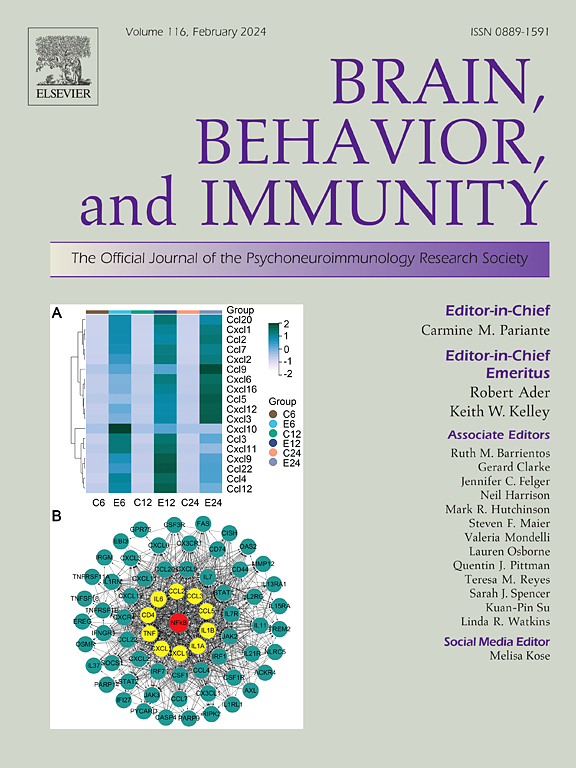Chronic intermittent hypoxia drives M1 macrophage polarization in dorsal root ganglia
IF 8.8
2区 医学
Q1 IMMUNOLOGY
引用次数: 0
Abstract
Immune cells play a crucial role in maintaining the health of all body tissues. When chemical signals are released into the local environment from injured or infected cells, tissue-specific immune cells become attracted and migrate to that area. Upon arrival, they begin releasing their own signals that produce a cascade of effects, including pain modulation. However, little is known about how systemic hypoxia influences immune modulation of pain in the peripheral nervous system. We sought to identify the unique role of macrophages in peripheral sensory ganglia by using a translational model of sleep apnea. Mice were exposed to chronic intermittent hypoxia (CIH) for 14 days and L4-L6 dorsal root ganglia were removed for analyses of macrophage content. Immunofluorescence histochemistry and fluorescence-activated cell sorting indicate a prevalence of M1 macrophage markers and a reduction of M2 macrophage markers in DRG tissues taken from CIH mice. Total RNA-seq identified multiple genes upregulated in DRG macrophages following CIH exposure, including toll-like receptor 9 (TLR9). In vitro treatment of primary macrophage cultures with the FDA-approved TLR9 antagonist hydroxychloroquine (HCQ) inhibited M1 macrophage polarization. Calcium imaging of DRG neurons taken from CIH-exposed mice revealed hypersensitivity to KCL that was prevented by HCQ co-treatment. Furthermore, HCQ acutely abated hyperalgesic priming behavior in mice exposed to CIH. Together, these results identify TLR9 as a druggable target capable of reducing nociceptor sensitization in CIH, with implications for exaggerated pain sensitivity in patients with sleep apnea.
慢性间歇性缺氧驱动背根神经节M1巨噬细胞极化
免疫细胞在维持身体所有组织的健康方面起着至关重要的作用。当化学信号从受伤或感染的细胞释放到局部环境中时,组织特异性免疫细胞被吸引并迁移到该区域。到达后,它们开始释放自己的信号,产生一系列的效应,包括疼痛调节。然而,关于全身缺氧如何影响周围神经系统疼痛的免疫调节,我们知之甚少。我们试图通过使用睡眠呼吸暂停的翻译模型来确定巨噬细胞在周围感觉神经节中的独特作用。小鼠暴露于慢性间歇缺氧(CIH) 14天,去除L4-L6背根神经节,分析巨噬细胞含量。免疫荧光组织化学和荧光活化细胞分选表明,在取自CIH小鼠的DRG组织中,M1巨噬细胞标记物普遍存在,M2巨噬细胞标记物减少。总RNA-seq鉴定了CIH暴露后DRG巨噬细胞中上调的多个基因,包括toll样受体9 (TLR9)。用fda批准的TLR9拮抗剂羟氯喹(HCQ)体外处理原代巨噬细胞培养物可抑制M1巨噬细胞极化。来自cih暴露小鼠的DRG神经元的钙成像显示对KCL的超敏反应,HCQ共处理可防止这种反应。此外,HCQ能显著减轻暴露于CIH的小鼠的痛觉过敏启动行为。综上所述,这些结果确定TLR9是一种能够降低CIH中伤害感受器致敏的药物靶点,对睡眠呼吸暂停患者的过度疼痛敏感性具有指导意义。
本文章由计算机程序翻译,如有差异,请以英文原文为准。
求助全文
约1分钟内获得全文
求助全文
来源期刊
CiteScore
29.60
自引率
2.00%
发文量
290
审稿时长
28 days
期刊介绍:
Established in 1987, Brain, Behavior, and Immunity proudly serves as the official journal of the Psychoneuroimmunology Research Society (PNIRS). This pioneering journal is dedicated to publishing peer-reviewed basic, experimental, and clinical studies that explore the intricate interactions among behavioral, neural, endocrine, and immune systems in both humans and animals.
As an international and interdisciplinary platform, Brain, Behavior, and Immunity focuses on original research spanning neuroscience, immunology, integrative physiology, behavioral biology, psychiatry, psychology, and clinical medicine. The journal is inclusive of research conducted at various levels, including molecular, cellular, social, and whole organism perspectives. With a commitment to efficiency, the journal facilitates online submission and review, ensuring timely publication of experimental results. Manuscripts typically undergo peer review and are returned to authors within 30 days of submission. It's worth noting that Brain, Behavior, and Immunity, published eight times a year, does not impose submission fees or page charges, fostering an open and accessible platform for scientific discourse.

 求助内容:
求助内容: 应助结果提醒方式:
应助结果提醒方式:


